Abstract
BACKGROUND--The combined use of wrist actigraphic assessment and self assessment of sleep in the screening of obstructive sleep apnoea syndrome was evaluated in a community based sample. METHODS--One hundred and sixteen community based subjects clinically suspected of having obstructive sleep apnoea (syndrome) were evaluated by means of simultaneous ambulatory recording of respiration (oronasal flow thermistry), motor activity (wrist actigraphy), and subjective sleep (sleep log) during one night of sleep. RESULTS--The subjects were distributed according to their apnoea index (AI); AI < 1 (non-apnoeic snorers) 44%; AI 1- < 5 39%; and AI > or = 5 17%. High apnoea index values were associated with self reported disturbed sleep initiation and more fragmented and increased levels of motor activity and decreased duration of immobility periods, particularly in those with an apnoea index of > or = 5. Across subjects the duration of immobility periods was the only predictor of the apnoea index, explaining 11% of its variance. Use of the multiple regression equation to discriminate retrospectively between those with an apnoea index of < 1 and > or = 5 resulted in sensitivity and specificity values of 75% and 43%, and 5% and 100%, respectively. CONCLUSIONS--The combined use of a sleep log and actigraphic assessment of sleep failed to identify reliably those subjects who suffered from obstructive sleep apnoea (syndrome) in a sample of community based subjects reporting habitual snoring combined with excessive daytime sleepiness and/or nocturnal respiratory arrests.
Full text
PDF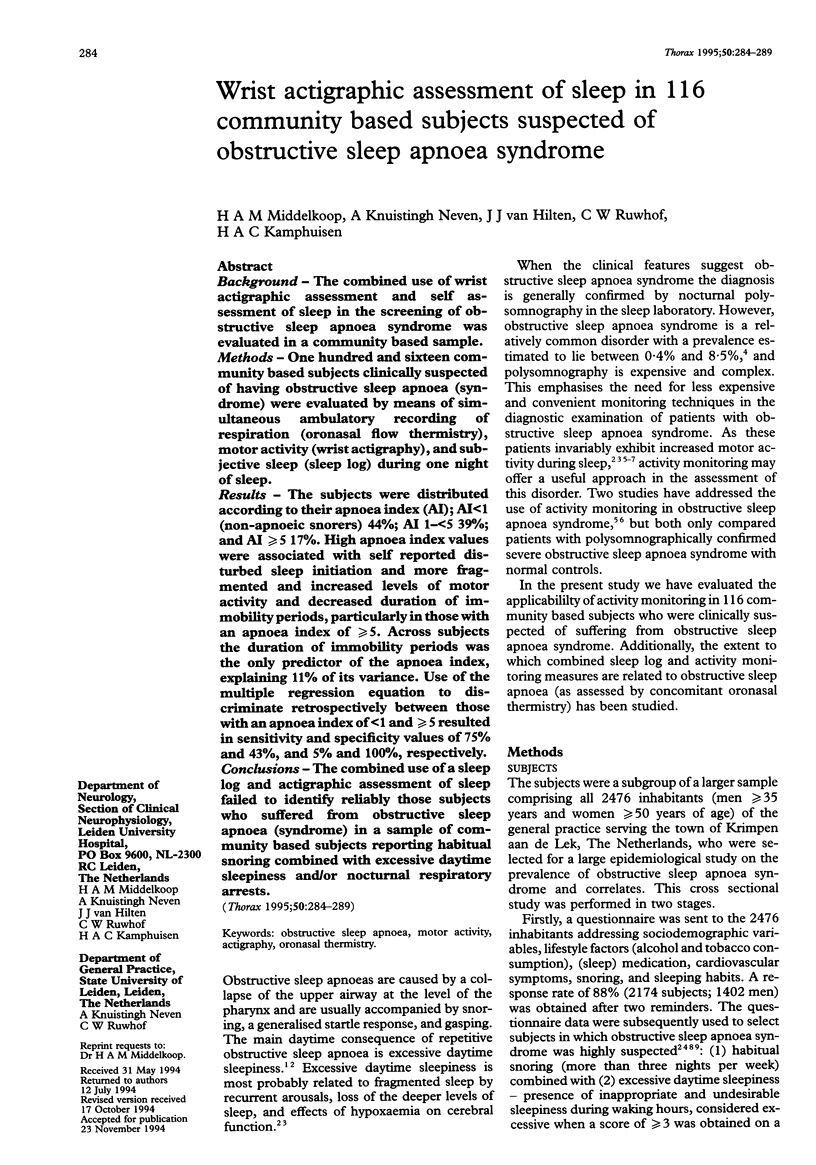
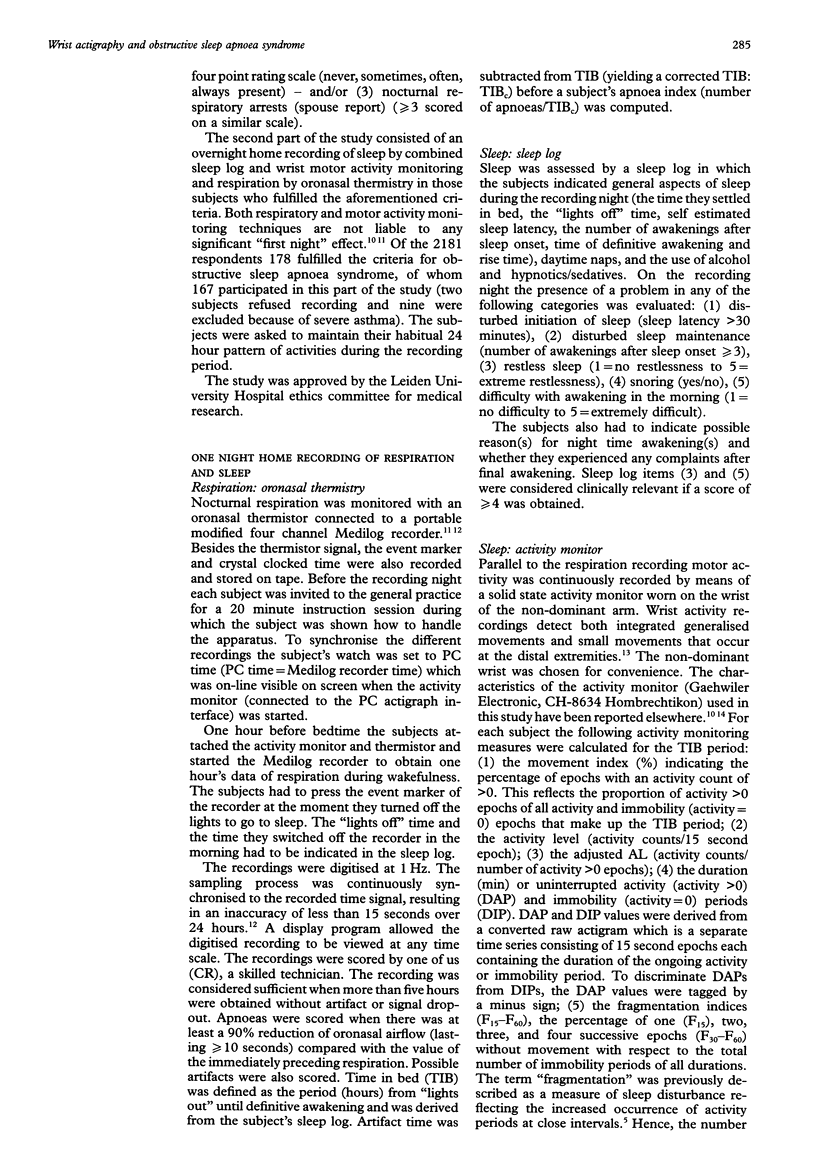
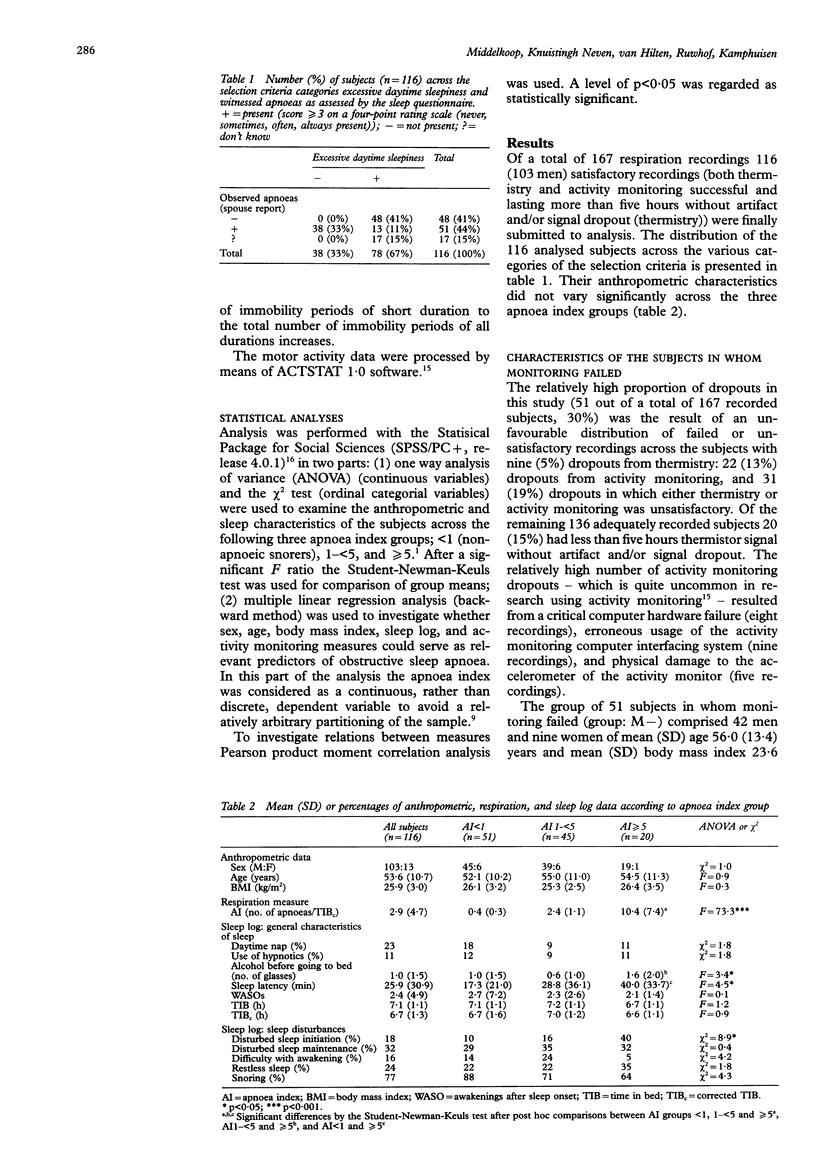
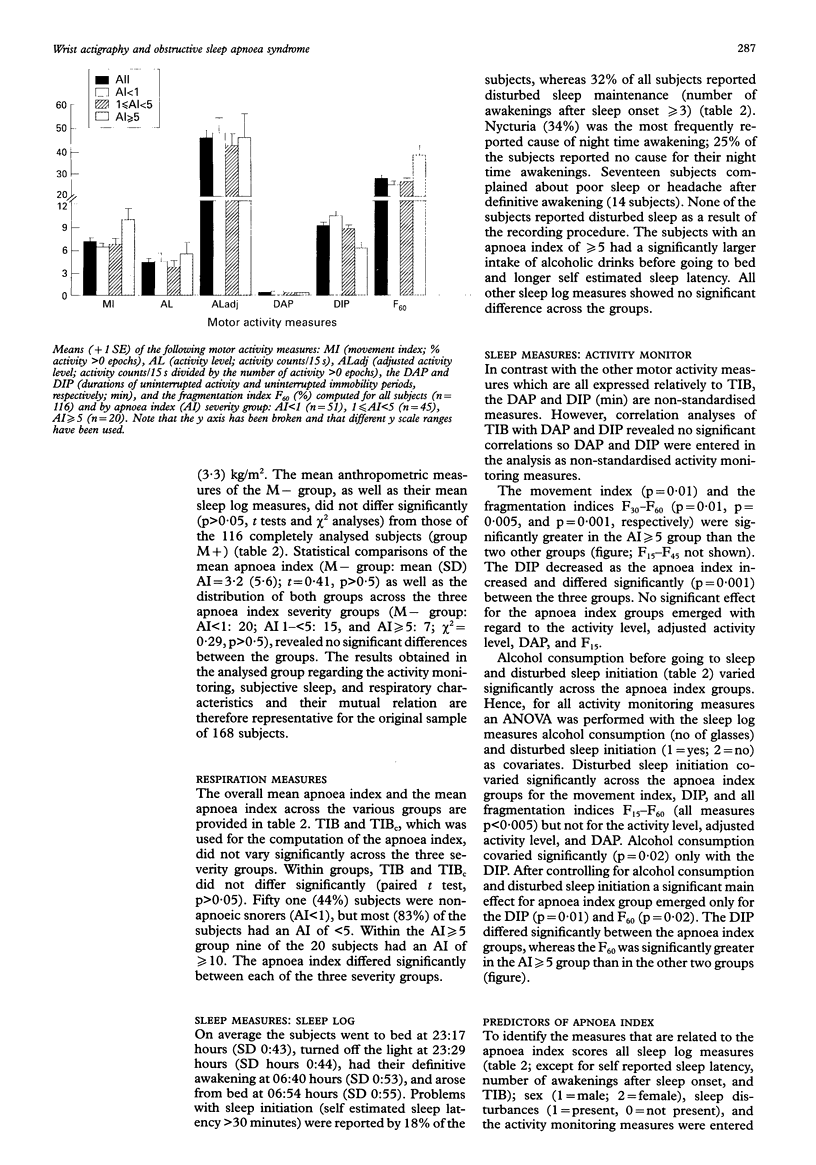
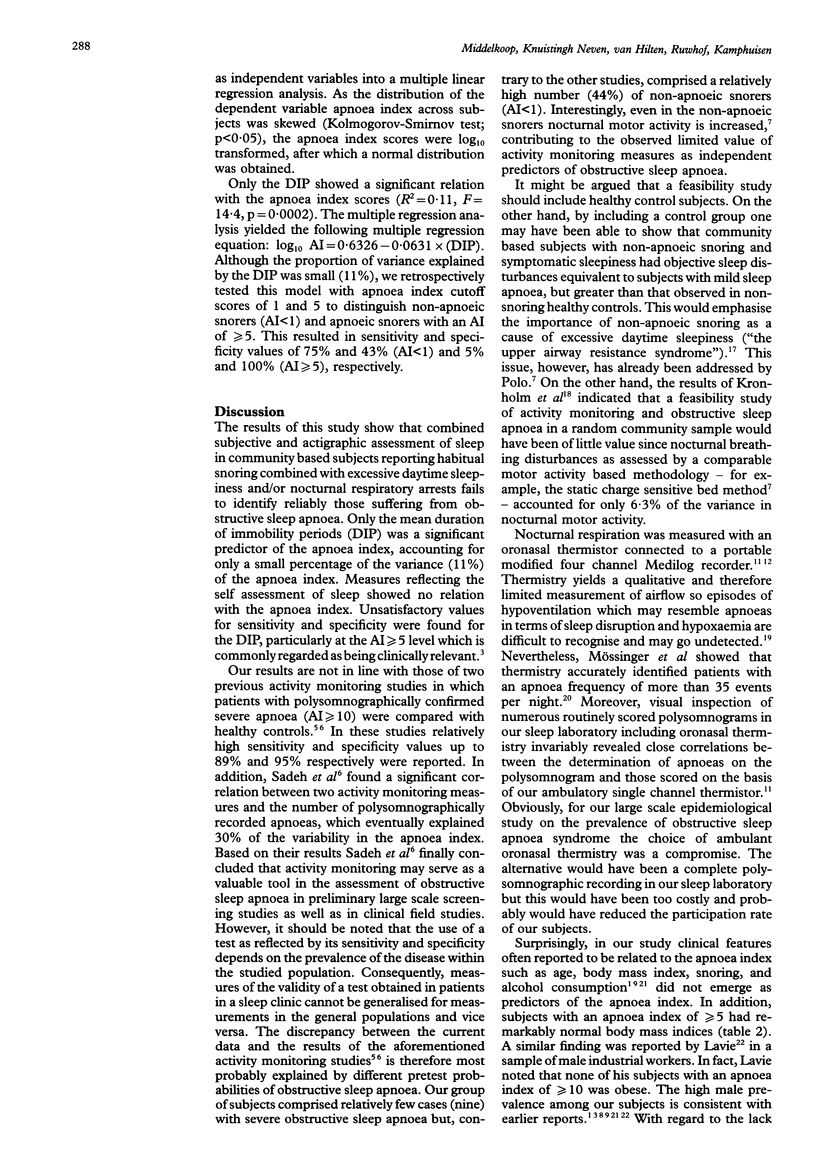
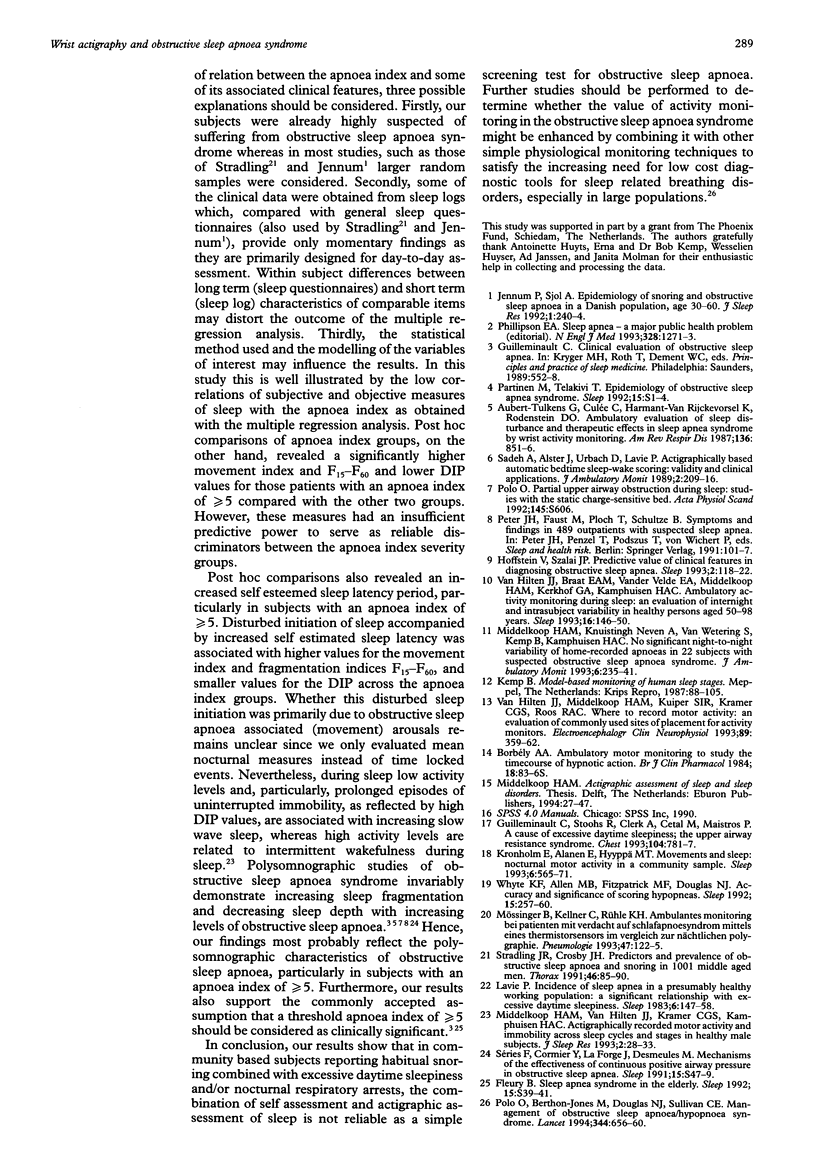
Images in this article
Selected References
These references are in PubMed. This may not be the complete list of references from this article.
- Al-Safi S. A., Maddocks J. L. Effect of levamisole and azathioprine on the human mixed lymphocyte reaction (MLR). Br J Clin Pharmacol. 1984 Jul;18(1):83–85. doi: 10.1111/j.1365-2125.1984.tb05025.x. [DOI] [PMC free article] [PubMed] [Google Scholar]
- Aubert-Tulkens G., Culée C., Harmant-Van Rijckevorsel K., Rodenstein D. O. Ambulatory evaluation of sleep disturbance and therapeutic effects in sleep apnea syndrome by wrist activity monitoring. Am Rev Respir Dis. 1987 Oct;136(4):851–856. doi: 10.1164/ajrccm/136.4.851. [DOI] [PubMed] [Google Scholar]
- Fleury B. Sleep apnea syndrome in the elderly. Sleep. 1992 Dec;15(6 Suppl):S39–S41. doi: 10.1093/sleep/15.suppl_6.s39. [DOI] [PubMed] [Google Scholar]
- Guilleminault C., Stoohs R., Clerk A., Cetel M., Maistros P. A cause of excessive daytime sleepiness. The upper airway resistance syndrome. Chest. 1993 Sep;104(3):781–787. doi: 10.1378/chest.104.3.781. [DOI] [PubMed] [Google Scholar]
- Hoffstein V., Szalai J. P. Predictive value of clinical features in diagnosing obstructive sleep apnea. Sleep. 1993 Feb;16(2):118–122. [PubMed] [Google Scholar]
- Jennum P, Sjøl A. Epidemiology of snoring and obstructive sleep apnoea in a Danish population, age 30-60. J Sleep Res. 1992 Dec;1(4):240–244. doi: 10.1111/j.1365-2869.1992.tb00045.x. [DOI] [PubMed] [Google Scholar]
- Kronholm E., Alanen E., Hyyppä M. T. Nocturnal motor activity in a community sample. Sleep. 1993 Sep;16(6):565–571. doi: 10.1093/sleep/16.6.565. [DOI] [PubMed] [Google Scholar]
- Marchini E. J., Coates T. J., Magistad J. G., Waldum S. J. What do insomniacs do, think, and feel during the day? A preliminary study. Sleep. 1983;6(2):147–155. doi: 10.1093/sleep/6.2.147. [DOI] [PubMed] [Google Scholar]
- Middelkoop HA, Van Hilten BJ, Kramer CG, Kamphuisen HA. Actigraphically recorded motor activity and immobility across sleep cycles and stages in healthy male subjects. J Sleep Res. 1993 Mar;2(1):28–33. doi: 10.1111/j.1365-2869.1993.tb00057.x. [DOI] [PubMed] [Google Scholar]
- Mössinger B., Kellner C., Rühle K. H. Ambulantes Monitoring bei Patienten mit Verdacht auf Schlafapnoesyndrom mittels eines Thermistorsensors im Vergleich zur nächtlichen Polygraphie. Pneumologie. 1993 Mar;47 (Suppl 1):122–125. [PubMed] [Google Scholar]
- Partinen M., Telakivi T. Epidemiology of obstructive sleep apnea syndrome. Sleep. 1992 Dec;15(6 Suppl):S1–S4. doi: 10.1093/sleep/15.suppl_6.s1. [DOI] [PubMed] [Google Scholar]
- Phillipson E. A. Sleep apnea--a major public health problem. N Engl J Med. 1993 Apr 29;328(17):1271–1273. doi: 10.1056/NEJM199304293281712. [DOI] [PubMed] [Google Scholar]
- Polo O., Berthon-Jones M., Douglas N. J., Sullivan C. E. Management of obstructive sleep apnoea/hypopnoea syndrome. Lancet. 1994 Sep 3;344(8923):656–660. doi: 10.1016/s0140-6736(94)92089-3. [DOI] [PubMed] [Google Scholar]
- Stradling J. R., Crosby J. H. Predictors and prevalence of obstructive sleep apnoea and snoring in 1001 middle aged men. Thorax. 1991 Feb;46(2):85–90. doi: 10.1136/thx.46.2.85. [DOI] [PMC free article] [PubMed] [Google Scholar]
- Sériès F., Cormier Y., La Forge J., Desmeules M. Mechanisms of the effectiveness of continuous positive airway pressure in obstructive sleep apnea. Sleep. 1992 Dec;15(6 Suppl):S47–S49. [PubMed] [Google Scholar]
- Van Hilten J. J., Middelkoop H. A., Kuiper S. I., Kramer C. G., Roos R. A. Where to record motor activity: an evaluation of commonly used sites of placement for activity monitors. Electroencephalogr Clin Neurophysiol. 1993 Oct;89(5):359–362. doi: 10.1016/0168-5597(93)90076-2. [DOI] [PubMed] [Google Scholar]
- Whyte K. F., Allen M. B., Fitzpatrick M. F., Douglas N. J. Accuracy and significance of scoring hypopneas. Sleep. 1992 Jun;15(3):257–260. doi: 10.1093/sleep/15.3.257. [DOI] [PubMed] [Google Scholar]
- van Hilten J. J., Braat E. A., van der Velde E. A., Middelkoop H. A., Kerkhof G. A., Kamphuisen H. A. Ambulatory activity monitoring during sleep: an evaluation of internight and intrasubject variability in healthy persons aged 50-98 years. Sleep. 1993 Feb;16(2):146–150. doi: 10.1093/sleep/16.2.146. [DOI] [PubMed] [Google Scholar]



